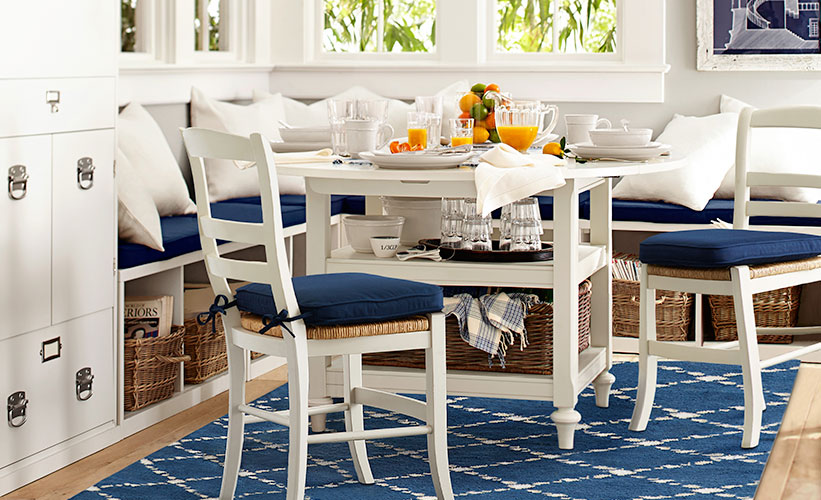8 Tips for a Small Dining Space
Let’s face it: the dining room is action-packed. Between homework time, sharing meals with loved ones and hosting large family gatherings, your small dining room needs to versatile. Whether your dining room is a small alcove attached to your living room or a corner of your kitchen, a little bit of creativity can make the space appear larger and accommodate more guests for your dinner parties and gatherings. Luckily, we compiled 8 decorating ideas to help you really love your small dining room.

1
Choose a Round Table
Round tables can accommodate more diners in a smaller amount of space, which makes them ideal for smaller dining areas. Opt for a table with pedestal legs to maximize the space-saving benefits, as this leg type does not get in the way of diners seated around the table. Bonus: round tables encourage conversation, as they allow plenty of eye contact with everyone else seated at the table.
2
Make Use of Mirrors
Wall mirrors can make almost any space appear bigger and brighter. A large mirror reflects the part of the room opposite to it, which creates the illusion of more space. If possible, hang the mirror opposite a window to reflect the view and amplify ambient natural lighting. If your space cannot accommodate a single large mirror, try hanging several smaller mirrors. Feeling lost? Our Pottery Barn installation experts will come to your house and help you hang up to 4 mirrors.
3
Place the Table Against the Wall
If you prefer the traditional style of a rectangular or square dining table, placing it against the wall can be an excellent way to work it into a slim dining area without compromising space to move around. Simply arrange the table against the wall and place chairs around the remaining sides.
4
Opt for Folding or Extending Furniture
Dining tables with leaflets or folding extensions offer plenty of flexibility for smaller spaces. They let you save space on a day-to-day basis, but can accommodate more diners when company calls. Keep a few folding chairs on hand to accommodate additional guests. These are easy to fold up and stow in a closet, basement or garage.
5
Use Shelves for Storage
Shelves offer a more open aesthetic than traditional cabinets and they take up much less space. Install wall shelves along an empty wall to store dishes, cutlery, napkins and other dining essentials. Wall shelves offer lots of flexibility in terms of placement and are less bulky than shelving units. If you are not able to hang things from your walls, consider a slim bookcase instead. Line baskets along the shelves to keep smaller items hidden and organized, and incorporate decorative objects to make the space more inviting.

6
Add Banquette Seating
Banquette and bench seating lets you accommodate more diners in a limited amount of space. You can also maximize space by incorporating shelving above your seating or choosing benches or banquettes with shelves or cubbies below the seat or even stealthy built-in storage compartments.
7
Make Use of Color and Lines
The colors you choose for your dining area can go a long way in making the space appear bigger. Brighter, bolder colors are great for creating an accent wall, but can also overwhelm the space. The key is to use color smartly, keeping the brightest and most saturated colors to just accent objects around the room. For walls, consider a patterned wall paper, a painted stencil or even temporary wall decals.
If bright, bold colors aren’t your style, you can get your feet wet working with color by choosing a non-neutral pastel. These produce a light, airy appearance and can make your dining area feel more inviting. You don’t even have to commit to paint: hang long drapes in the color and pattern of your choice to make your ceiling appear higher and roomier.
8
Incorporate Lots of Light
Adding more light is an easy way to create the appearance of more space in a small dining room. If possible, place your table and seating near a window and avoid window treatments that block natural light. Choose a lighting fixture that mirrors the shape of your table to avoid a cluttered appearance. If your dining area does not have any windows, consider adding a slim floor lamp to the corner of the room to produce more light.